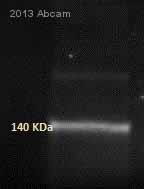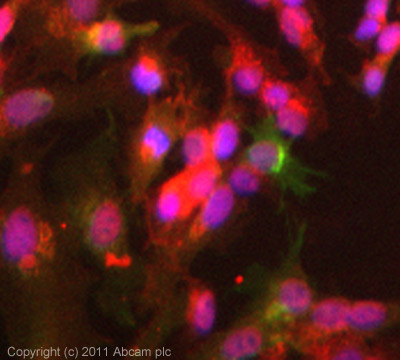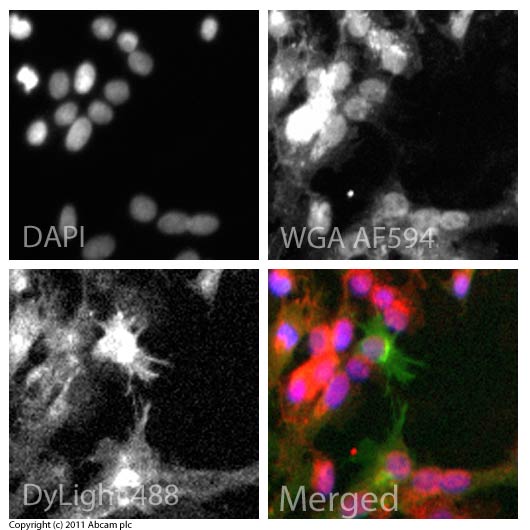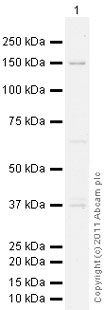
Anti-eNOS antibody (ab95254) at 1/250 dilution + Rabbit aorta tissue lysate at 40 µgSecondaryHRP-conjugated Donkey anti-rabbit IgG at 1/2500 dilutiondeveloped using the ECL techniquePerformed under reducing conditions.

All lanes : Anti-eNOS antibody (ab95254) at 1 µg/mlLane 1 : Placenta (Human) Tissue Lysate - adult normal tissue (ab29745)Lane 2 : HUVEC (Human Umbilical Vein Endothelial Cell) Whole Cell Lysate Lysates/proteins at 10 µg per lane.SecondaryGoat polyclonal Secondary Antibody to Rabbit IgG - H&L (HRP), pre-adsorbed at 1/5000 dilutiondeveloped using the ECL techniquePerformed under reducing conditions.

ICC/IF image of ab95254 stained HepG2 cells. The cells were 4% PFA fixed (10 min) and then incubated in 1%BSA / 10% normal goat serum / 0.3M glycine in 0.1% PBS-Tween for 1h to permeabilise the cells and block non-specific protein-protein interactions. The cells were then incubated with the antibody (ab95254, 5µg/ml) overnight at +4°C. The secondary antibody (green) was ab96899, DyLight® 488 goat anti-rabbit IgG (H+L) used at a 1/250 dilution for 1h. Alexa Fluor® 594 WGA was used to label plasma membranes (red) at a 1/200 dilution for 1h. DAPI was used to stain the cell nuclei (blue) at a concentration of 1.43µM.

ICC/IF image of ab95254 stained HepG2 cells. The cells were 4% formaldehyde fixed (10 min) and then incubated in 1%BSA / 10% normal goat serum / 0.3M glycine in 0.1% PBS-Tween for 1h to permeabilise the cells and block non-specific protein-protein interactions. The cells were then incubated with the antibody (ab95254, 5µg/ml) overnight at +4°C. The secondary antibody (green) was ab96899, DyLight® 488 goat anti-rabbit IgG (H+L) used at a 1/250 dilution for 1h. Alexa Fluor® 594 WGA was used to label plasma membranes (red) at a 1/200 dilution for 1h. DAPI was used to stain the cell nuclei (blue) at a concentration of 1.43µM.

Anti-eNOS antibody (ab95254) at 1 µg/ml + Heart (Mouse) Tissue Lysate at 10 µgSecondaryGoat Anti-Rabbit IgG H&L (HRP) preadsorbed (ab97080) at 1/5000 dilutiondeveloped using the ECL techniquePerformed under reducing conditions.




